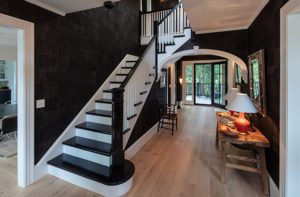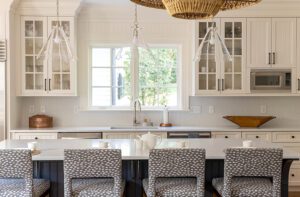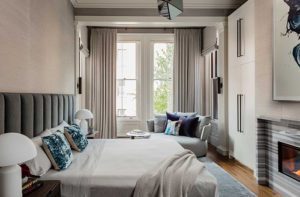Easy Accord
April 3, 2013
The amiability and mutual respect among the design professionals and their clients is reflected beautifully in the renovation of a Westport home that puts a contemporary twist on the Arts and Crafts tradition.
Text by Paula M. Bodah Photography by Michael Partenio Produced by Stacy Kunstel
Home remodeling projects are fraught with tension. The architect and the builder don’t see eye to eye. The designer and her clients can’t seem to get on the same wavelength. Husband and wife bicker over furniture choices or paint colors. Not so with this waterfront house in Westport. The whole design team, homeowners included, recalls the process fondly, each modestly insisting that everyone else’s talents were the key to the obvious success.
The progression from comfortable-enough house to a home that reflects the very souls of its owners began when the couple engaged architect Kenneth R. Nadler. The house, which sits on an enviable parcel overlooking an inlet of Long Island Sound, had been renovated by previous owners who added a second story but left the first level much as it was. The floor plan, with its full bath between the living room and dining rooms, might have made sense for a one-story house, but the new owners didn’t see the need for a large bathroom, complete with cast-iron tub, in the main living area. Besides, says the wife, she and her husband love visits from their large extended family. “An enclosed dining room didn’t work for us,” she says.
The kitchen, a tiny galley-style space hemmed in by a wall separating it from a casual eating area, was also wrong for a couple who value entertaining. The stairway leading from the foyer to the upstairs was closed in by a solid wall, wasting an opportunity to bring in light. And in the family room, an enormous built-in cabinet stood in the way of water views.
Working with Nadler’s plans, Norwalk builder Bob Bradshaw did away with the bathroom and turned the rooms on either side into one spacious dining space with a cozy sitting area at one end. The old tub found a new home in the builder’s Vermont house. “It’s a beautiful tub; I’m a big believer in recycling,” Bradshaw says.
In the kitchen, the interior wall came down, expanding the room to include two islands and plenty of countertop and cooking space while keeping the casual eating area.
The family room’s transformation began with replacing the built-ins with a big bow window that reclaims the water views. Bradshaw discovered that the second-story floor sat several feet above the family room ceiling. He knocked out the old ceiling, reclaiming the dead space above and giving the room the lofty feel it has today.
The entry, of course, is where a home’s interior makes its first impression. When the front door opens on the re-imagined foyer, the simpatico relationship between designer Joyce Clear and her clients becomes beautifully apparent.
The homeowners, Clear explains, have an affinity for the Arts and Crafts style, a passion for fine craftsmanship and an adventurous spirit. “As I got to know them, I saw that they have this amazingly creative side to them,” she says, “so I knew I could take the fundamentals of Arts and Crafts and go beyond it, into a more creative application.”
The couple already knew Gregory Clark, a Wilton artisan whose furniture they’d long loved. (In fact, Clark, who has worked often with Clear over the years, forged the introduction between designer and clients). “We have a similar mindset about design,” says Clark, who calls his work modernist with an Arts and Crafts execution. “They appreciate the artists’ hand, but they like the work to be advancing the art in some way.”
Clear, the homeowners and Clark collaborated on the design of the walnut stair railing, a true work of art with its serpentine banister and newel posts that incorporate a filigree element of laser-cut steel with a bronze finish. Like the white wood paneling that sheaths the stairway and the woven-grass-topped bench that sits alongside, the Arts and Crafts influence is unmistakable, but the result goes well beyond the traditional.
And so it is throughout the house. Almost every piece of furniture is custom-made, mostly by Clark. At the base of the walnut and macassar ebony dining table, which the homeowner happily notes can seat two dozen guests when fully expanded, Clark borrowed his own idea from the stairway’s newel posts, creating an apron of gold coral onyx embellished with laser-cut metal filigree. Shaker-influenced chairs outfitted in Bergamo chenille with a subtle metallic gleam make elegant companions to the table, while a Nakashima sideboard against a wall adds an Asian touch.
Clear’s design plan for the sitting area at the far end of the room began with a pair of Scandinavian chairs in an antiques store. “There were only two and we wanted four,” she says, “so I said, ‘Let’s invent them.’ ” She conferred with Clark, who crafted the Bolivian rosewood chairs as well as ottoman/coffee table they surround. Both dining and sitting areas are grounded by custom J.D. Staron rugs.
Here and throughout the first floor, the palette is soft and earthy, a blend of chocolate brown, coppers and beiges enlivened with light blues inspired by a painting of a sailboat the owners already had that now hangs in the sitting room.
The abstract tapestry above the fireplace set the tone for the family room. The Clark-designed fireplace, with a painted steel frame that holds fossilized marble tiles, makes a worthy display for the tapestry. Sofas with leather-covered frames and plush cushions and a bold coffee table keep company atop a J.D. Staron rug with raised circles inspired by the stones one might find on a walk along the nearby beach. Next to a sofa sits a side table (another Clark creation) whose top sandwiches the silvery leaves of a money plant between sheets of glass.
Upstairs renovations included expanding the master suite. Here, Clear added a bright but serene seafoam hue to the palette. She also designed the bed, which is nothing short of jaw-dropping, with its steel-framed headboard of tree bark between sheets of glass.
Clear credits teamwork for the beautiful outcome in this house. “I have no ego,” she says with a laugh. “If you work in an egoless environment, the ideas and exchanges you can have are so powerful, and you get a more comprehensive result.”
For her clients, the result is not only comprehensive, but beautiful, comfortable and perfectly in tune with who they are. •
Architecture: Kenneth R. Nadler Architects
Interior design: Joyce G. Clear, Clear Group International
Builder: Bob Bradshaw, Bradshaw Construction
Share
![NEH-Logo_Black[1] NEH-Logo_Black[1]](https://www.nehomemag.com/wp-content/uploads/2022/08/NEH-Logo_Black1-300x162.jpg)


















You must be logged in to post a comment.